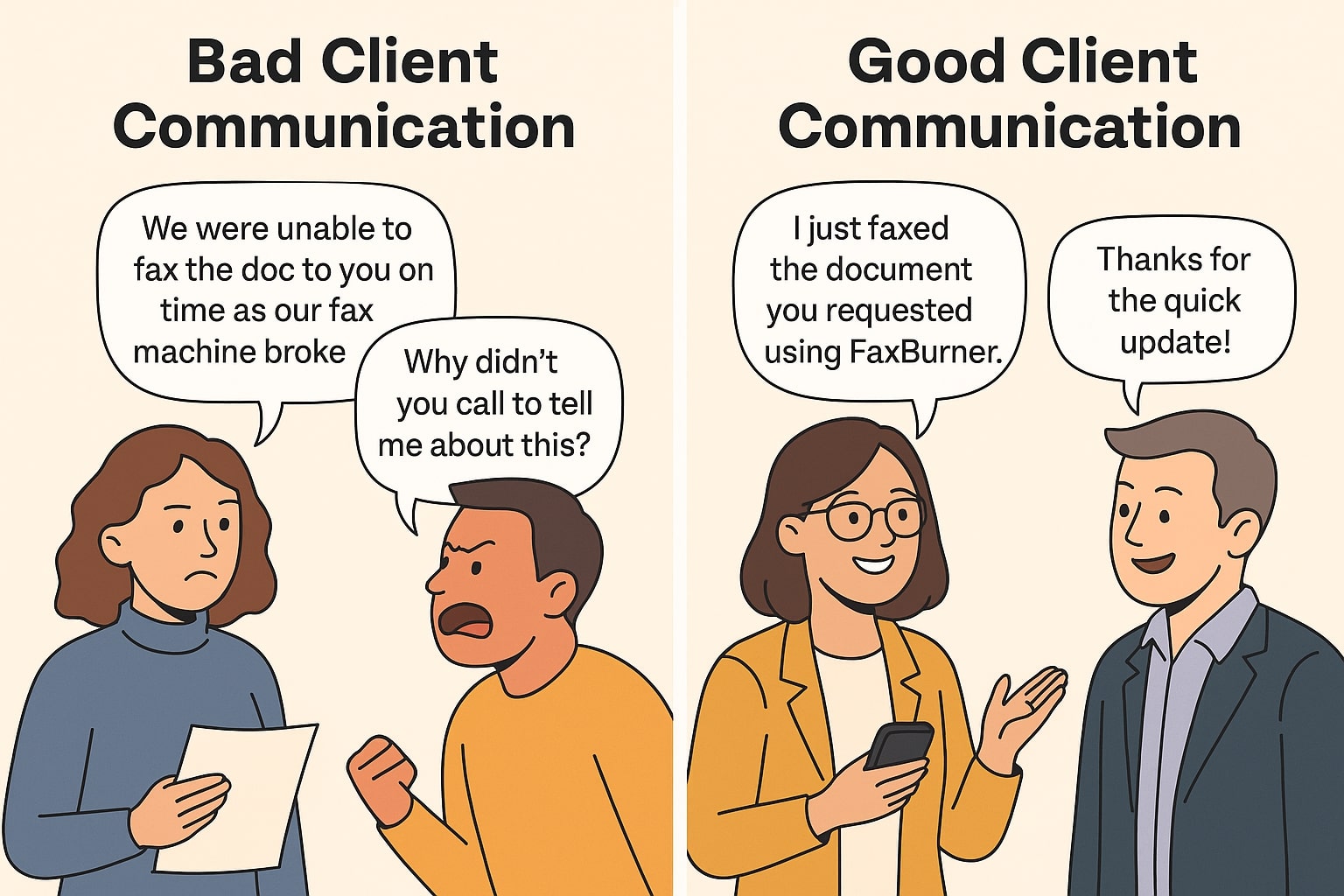Strong client communication keeps everything moving. But with remote setups, back-to-back emails, and so many tools flying around, things can easily fall through the cracks. Messages get buried, expectations get blurred, and frustration builds on both sides.
That’s why effective communication isn’t just a soft skill anymore; it’s a real advantage. Teams that get it right see better retention, fewer project delays, and smoother collaboration.
This post shares tips for effective business communication that actually work, even in today’s fast-paced, digital-first world. You’ll learn how to communicate better in business, choose the right channels, adapt your approach to different people, and keep client relationships strong over time.
Understanding Communication Styles and Preferences
People don’t process information the same way. Some clients want the bottom line right away. Others need context and detail before they decide anything. Knowing how your clients prefer to communicate can save you from confusion, backtracking, and missed deadlines.
Here’s a quick look at four common communication styles:
- Analytical: These are your facts-and-figures people. They prefer clear timelines, solid data, and logical updates. So keep your messages direct, structured, and easy to follow.
- Personal: These clients value connection. Take a moment to build rapport before getting into the details. A friendly tone makes your message feel more collaborative.
- Intuitive: These clients focus on outcomes. They don’t need every detail laid out; just the goal, the direction, and a clear sense of what’s ahead. So keep it sharp and forward-focused.
- Functional: These folks rely on structure. Use lists, organized notes, and repeat important info for clarity. The more predictable the flow, the easier it is for them to stay aligned.
One of the easiest client communication tips: just ask.
A quick “What’s the best way to keep in touch?” at the start can clear up a lot. Some clients want weekly emails. Others prefer quick chats or a shared dashboard. Check in now and then if the project scope shifts or new people join.
Also, be mindful of your own style. Some clients may find your default tone too direct or too casual. So read the room, adjust as needed, and always keep listening.
How to Choose Effective Communication Channels and Techniques
There’s no one-size-fits-all when it comes to communication tools. The right channel depends on the message, timing, and the people involved.
Misfires often happen when teams use the wrong method for the moment, like texting a contract or calling about something that could’ve been a quick Slack update.
That said, here’s how to match a communication tool to the task:
- Quick updates or casual check-ins: Use messaging platforms like Slack, Microsoft Teams, or text. These are great for internal chatter, fast clarifications, or nudging a response without overloading inboxes.
- Detailed info or official updates: Email works best when the message needs structure or documentation. It gives clients space to think and reply when ready. Plus, there’s a paper trail if you ever need to revisit what was said.
- Building rapport or clearing up confusion: Go with a phone or video call. Tone, facial expressions, and real-time back-and-forth make it easier to avoid misunderstandings when stakes are high or nuance matters.
- Signed paperwork, forms, or official documents: This is where fax still has a solid place in professional workflows. Legal, medical, and consulting fields still use faxing daily to move signed materials quickly.
To avoid communication gaps, build a simple channel strategy around three things:
- Urgency – Is this time-sensitive or can it wait?
- Message type – Is it informational, transactional, or decision-making?
- Client preferences – What method do they use most or respond to fastest?
Build Long-Term Trust Through Consistent, Transparent Communication
Trust isn’t built in one meeting. It grows through repeated, reliable contact when clients feel like you’re on top of things and always honest, even when things go sideways. That kind of consistency makes your work easier and your relationships stronger.
Here are client communication tips that can help build trust over time:
- Keep them in the loop: Silence makes people anxious. Even if there’s no major update, a quick check-in shows clients you’re still thinking about their project. Use scheduled emails or short messages to let them know where things stand during slower phases.
- Own your mistakes and act fast: Things don’t always go according to plan. Maybe a file was late or a feature didn’t launch as expected. What matters is how quickly you acknowledge it and explain what’s being done about it. Clients don’t expect perfection, but they do expect accountability.
- Follow up after key calls or milestones: After a meeting, send a summary: what was discussed, what’s next, and who’s doing what. It prevents confusion, avoids missed tasks, and shows that you value clarity. Plus, it gives both sides something to refer back to.
- Stay consistent in tone and approach: Jumping between casual and overly formal can feel disjointed. Use a tone that matches your brand and your relationship with the client, and keep it steady. That stability reinforces credibility.
- Don’t overpromise just to please: Being clear about what can and can’t be done avoids disappointment later. It’s better to slightly underpromise and deliver with impact than to stretch thin and miss the mark.
Tips for Effective Client Communication in Remote/Hybrid Settings
Remote and hybrid setups changed how people stay in touch, and not always for the better. Messages slip through the cracks, meetings feel endless, and everyone’s juggling notifications from five different platforms.
However, with the right approach, you can still have clear, consistent communication that keeps projects on track and clients feeling supported.
Here are tips for effective client communication that work across time zones, platforms, and work styles:
- Schedule short but regular check-ins: A quick 15-minute call once a week can prevent hours of confusion later. It keeps everyone in sync and gives clients space to voice questions before they become problems.
- Confirm tasks in writing: Follow up on calls or chats with a short recap—“Just confirming: we’re updating the design mockups by Friday, and you’ll review on Monday.” It creates clarity and keeps everyone accountable without micromanaging.
- Match tone and style when it feels right: If a client writes in a warm, casual tone, mirror that in your replies (while keeping it professional). If they keep things short and to the point, do the same. It shows respect for their rhythm.
- Respect digital boundaries: Not everything needs an instant reply. So let clients know when they can expect responses (“e.g., I usually reply within 24 hours”) so they don’t feel left in the dark. This can help avoid stress on both sides.
- Be intentional with tools: Use the platform that fits the message. Don’t schedule a meeting just to ask a yes/no question, and don’t rely on DMs for contract details. Respect their time and yours by choosing wisely.
Strengthen Internal Communication for Team Efficiency
Your client experience starts with your internal team. If your team’s disorganized, unclear, or always waiting on answers, that energy spills straight into your client work.
Tight internal communication creates smoother handoffs, faster responses, and fewer “sorry for the delay” emails.
Here are a few corporate communication tips to clean things up behind the scenes:
- Keep updates async when possible: You don’t need a meeting to say “design is done” or “client approved the draft.” Use project trackers, dashboards, or status docs to post updates where everyone can check in when it works for them.
- Use meetings only when they actually solve something: If there’s no agenda, no decisions to make, or no one knows why they’re there, skip it. Structure matters. Save calls for brainstorming, alignment, or problem-solving, not status checks.
- Centralize everything: Scattered files and one-off messages kill momentum. Use shared drives, organized folders, and clear naming systems. That way, anyone can jump in without needing a scavenger hunt.
- Build habits that reduce noise: Daily check-ins in Slack, weekly wrap-ups via email, or Monday task lists in Trello; whatever your system is, make it consistent. The more your team runs on habit, the fewer gaps clients will feel.
Apply These Tips for Effective Business Communication
Client relationships don’t usually fall apart because of one mistake. It’s the lack of structure, clarity, and follow-through that slowly chips away at trust. That’s why strong communication isn’t about saying more—it’s about saying the right thing at the right time, through the right channel.
Here’s what to focus on:
- Know who you’re talking to: Every client has a different rhythm. Some want the big picture, others need every detail. Start by understanding how they like to communicate, then match that in your updates, calls, and follow-ups.
- Use the right tools for the message: Don’t just rely on email or Slack because they’re easy. Match the tool to the task. Short update? Message it. Formal doc? Email or fax it. Complex issue? Call. When you choose wisely, people feel more respected and less overwhelmed.
- Stay visible and reliable: Clients shouldn’t have to chase you for updates. A quick “nothing new yet” message goes a long way. And when something goes wrong, own it, explain what’s next, and fix it fast. That’s what builds trust.
- Make remote work smoother with structure: It’s easy to lose track of tasks or tone when you’re working across time zones. Check in regularly, confirm tasks in writing, and set reply-time expectations. Keep the flow calm, not chaotic.
- Tighten your internal team comms: Everything you do with clients starts with how your team communicates. Keep updates visible, organize files, avoid unnecessary meetings, and create repeatable habits. When your internal setup works, your external service improves automatically.
Final Thoughts
Clear communication isn’t just a nice-to-have; it’s what keeps projects moving, builds trust, and turns one-time clients into long-term partners. The more intentional you are with how, when, and why you reach out, the less time you spend fixing avoidable problems.
If you’re managing a team, working solo, or juggling multiple clients, strong communication habits take pressure off everyone. Therefore, choose better tools, speak to people the way they prefer, and stay consistent.




